

Michael Burry: “Inside the Doomsday Machine with the Outsider who Predicted and Profited from Americaâs Financial Armageddon” Posted Wednesday, April 13, 2011 — 4:30 PM Watch video of Michael Burry speaking April 5 on “Missteps to Mayhem: Inside the Doomsday Machine with the Outsider who Predicted and Profited from America’s Financial Armageddon,” as part of the 2010-2011 Chancellor’s Lecture Series.

Burry, a Vanderbilt University School of Medicine alumnus profiled in author Michael Lewis’ bestselling book The Big Short, is best-known as the first financial analyst to predict America’s financial crisis. In an op-ed he wrote for the New York Times in 2010, Burry says that he began worrying about the housing marketing in 2003 when “lenders first resurrected interest-only mortgages, loosening their credit standards to generate a greater volume of loans.” By 2005, he was convinced that the housing market would melt down causing “substantial damage to the economy.” “Our leaders in Washington either willfully or ignorantly aided and abetted the bubble,” wrote Burry.
Having trouble watching? Embed this video. Op-Ed Contributor - I Saw the Crisis Coming. Why Didn’t the Fed? Understanding the financial crisis. Book Review If you only read one book about the financial crisis, read “The Fall of the House of Credit” by Alistair Milne, a professor of financial economics at Loughborough University in Leicestershire, UK, north of London.
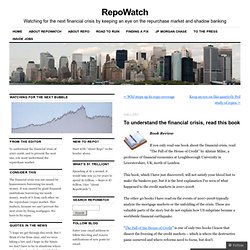
This book, which I have just discovered, will not satisfy your blood lust to make the bankers pay, but it is the best explanation I’ve seen of what happened to the credit markets in 2007-2008. The other 40 books I have read on the events of 2007-2008 typically analyze the mortgage markets or the unfolding of the crisis. These are valuable parts of the story but do not explain how US subprime became a worldwide financial earthquake. Reading About the Financial Crisis: A 21-Book Review by Andrew Lo. Massachusetts Institute of Technology (MIT) - Sloan School of Management; Massachusetts Institute of Technology (MIT) - Computer Science and Artificial Intelligence Laboratory (CSAIL); National Bureau of Economic Research (NBER)October 26, 2011 Abstract: The recent financial crisis has generated many distinct perspectives from various quarters.
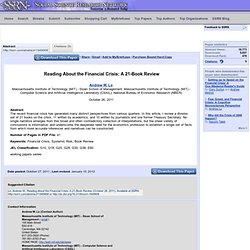
In this article, I review a diverse set of 21 books on the crisis, 11 written by academics, and 10 written by journalists and one former Treasury Secretary. No single narrative emerges from this broad and often contradictory collection of interpretations, but the sheer variety of conclusions is informative, and underscores the desperate need for the economics profession to establish a single set of facts from which more accurate inferences and narratives can be constructed. Number of Pages in PDF File: 41. A Narrowing Gyre. When the Journal of Economic Literature appears next month, it will contain two review essays surveying broadly the literature that has appeared so far on the financial crisis and its aftermath.

For anyone who doesn’t want to wait, both articles are available now as working papers at Social Science Research Network. What An Economist Learned From Reading 21 Books About The Crisis : Planet Money. Hide captionNow read 15 more.
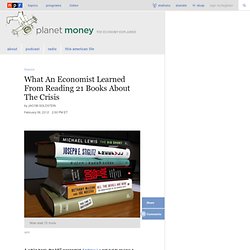
A while back, the MIT economist Andrew Lo set out to review a couple books about the financial crisis. Those books led to a couple more books, which led — you see where this is going — to 17 more books. Now, Lo is about to publish "Reading About The Financial Crisis: A 21-Book Review" (PDF).
Reading 21 books about the financial crisis does not sound, on its face, like a fun experience. After you talk to Lo, it sounds even worse. "After each book, I felt like I knew less," he told me. Lo read widely. He knew going in that there was still disagreement over the finer points of the crisis. "If you got five economists in a room and you asked them what caused the crisis, you'd probably get eight different opinions," he says.
For Lo, this is a problem. You have ... hundreds of scientists who have a number of varying perspectives. Lo knows that there aren't "laws of physics that will govern all economic behavior. " The Fall of the House of Credit. How was it possible for problems in one relatively small sector in the global financial system - the American sub-prime mortgage market - to lead to the most serious economic crisis in living memory?
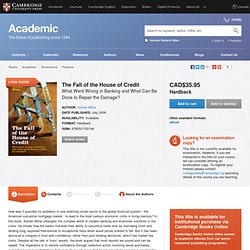
In this book, Alistair Milne untangles the complex world of modern banking and examines solutions to the crisis. He shows how the banks misused their ability to securitize loans and, by borrowing short and lending long, exposed themselves to exceptional risks when asset prices started to fall. But it has been above all a collapse in trust and confidence, rather than poor lending decisions, which has fuelled the crisis. Despite all the talk of 'toxic' assets, the book argues that most assets are sound and can be repaid. The imperative is to restore confidence through collective action involving asset purchases, guarantees and recapitalization. Slapped by the Invisible Hand.
Yale School of Management. Available online at: Before 2007, economists thought that financial crises would never happen again in the United States, that such upheavals were a thing of the past.

In this book I argue that economists fundamentally misunderstand what financial crises are, why they occur, and why there were none in the U.S. from 1934 to 2007. Economists looked from a certain point of view and missed everything that was important: the evolution of capital markets and the banking system, the existence of new financial instruments, and the size of certain money markets like the sale and repurchase market. How could that have happened? Misunderstanding Financial Crises offers an overview of financial crises, and shows that they are not rare, idiosyncratic events caused by a perfect storm of unconnected factors. Available online at: ANATOMY OF A CRASH. Janet Tavakoli on Causes and Culprits of the Financial Crisis - Jim Nichols. John Lanchester · The Art of Financial Disaster · LRB 15 December 2011.
No essay in English has a better title than De Quincey’s ‘On Murder Considered as One of the Fine Arts’.
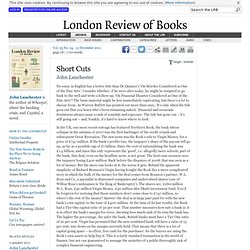
I wonder whether, if he were alive today, he might be tempted to go back to the well and write a follow-up, ‘On Financial Disaster Considered as One of the Fine Arts’? The basic material might be less immediately captivating, but there’s a lot to choose from. As Warren Buffett has pointed out more than once, ‘It’s only when the tide goes out that you learn who’s been swimming naked.’ Financial and economic downturns always cause a rash of scandals and exposure. The tide has gone out – it’s still going out – and, frankly, it’s hard to know where to look. “No-one saw this coming?” Balderdash! EmailShare 48EmailShare The widely believed proposition that this financial crisis was "a tsunami that no-one saw coming", and that could not have been predicted, has been given the lie to by an excellent survey of economic models by Dirk Bezemer, a Professor of Economics at the University of Groningen in the Netherlands.
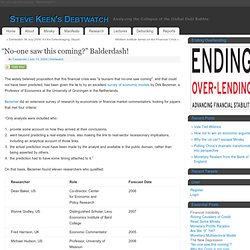
Bezemer did an extensive survey of research by economists or financial market commentators, looking for papers that met four criteria: “Only analysts were included who: provide some account on how they arrived at their conclusions.went beyond predicting a real estate crisis, also making the link to real-sector recessionary implications, including an analytical account of those links.the actual prediction must have been made by the analyst and available in the public domain, rather than being asserted by others.the prediction had to have some timing attached to it.” On that basis, Bezemer found eleven researchers who qualified: He identified four common elements: How come?
Why Did Economists Fail to Predict the Crisis? - I think about it every day: "Why did so many investors have to be hurt by the financial crisis of 2008"?
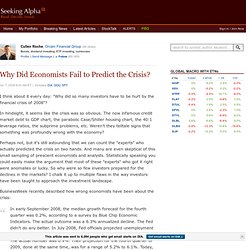
In hindsight, it seems like the crisis was so obvious. The now infamous credit market debt to GDP chart, the parabolic Case/Shiller housing chart, the 40:1 leverage ratios, the subprime problems, etc. Weren't they telltale signs that something was profoundly wrong with the economy? Financial Crisis for Beginners. We believe that everyone should be able to understand how the financial crisis came about, what it means for all of us, and what our options are for getting out of it. Unfortunately, the vast majority of all writing about the crisis – including this blog – assumes some familiarity with the world of mortgage-backed securities, collateralized debt obligations, credit default swaps, and so on.
You’ve probably heard dozens of journalists use these terms without explaining what they mean. If you’re confused, this page is for you. Over time, we will be adding more explanations and more links to external sources, so check back for updates. (Some of the explanations on this page are simplified and not 100% accurate; their goal is to explain the key concepts to a general audience.) Contents Articles on this page Separate posts Planet Money collaboration National debt Radio Video Paddy Hirsch of Marketplace has a great explanation of CDOs and secondary CDOs (Oct. 2008; 6 min.). Other web sites. How did we get here? perspectives...